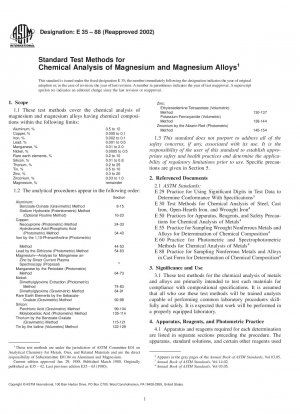ASTM E35-88(2002)
Standard Test Methods for Chemical Analysis of Magnesium and Magnesium Alloys
- Standard No.
- ASTM E35-88(2002)
- Release Date
- 1988
- Published By
- American Society for Testing and Materials (ASTM)
- Status
- 2008-10
- Latest
- ASTM E35-88(2002)
- Scope
These test methods for the chemical analysis of metals and alloys are primarily intended to test such materials for compliance with compositional specifications. It is assumed that all who use these test methods will be trained analysts capable of performing common laboratory procedures skillfully and safely. It is expected that work will be performed in a properly equipped laboratory.
1.1 These test methods cover the chemical analysis of magnesium and magnesium alloys having chemical compositions within the following limits:
Aluminum, % 0.5 to 12 Copper, % 0.005 to 0.1 Iron, % 0.002 to 0.1 Lead, % 0.001 to 0.5 Manganese, % 0.01 to 2.0 Nickel, % 0.0005 to 0.5 Rare earth elements, % 0.2 to 10 Silicon, % 0.01 to 0.8 Thorium, % 0.2 to 25 Tin, % 0.5 to 10 Zinc, % 0.3 to 20 Zirconium, % 0.03 to 1.0 Magnesium, % remainder 1.2 The analytical procedures appear in the following order:
Section Aluminum: Benzoate-Oxinate (Gravimetric) Method 8-15 Sodium Hydroxide (Potentiometric) Method (Optional Routine Method) 16-23 Copper: Neocuproine (Photometric) Method 24-33 Hydrobromic Acid-Phosphoric Acid (Photometric) Method 34-43 Iron by the 1,10-Phenanthroline (Photometric) Method 44-53 Lead by the Dithizone (Photometric) Method 54-63 Magnesium-Analysis for Manganese an Zinc by Direct Current Plasma Spectroscopy (Proposal) Manganese by the Periodate (Photometric) Method 64-73 Nickel: Dimethylglyoxime Extraction (Photometric) Method 74-83 Dimethylglyoxime (Gravimetric) Method 84.-91 Rare Earth Elements by the Sebacate-Oxalate (Gravimetric) Method 92-98 Silicon: Perchloric Acid (Gravimetric) Method 99-104 Molybdosilicic Acid (Photometric) Method 105-114 Thorium by the Benzoate-Oxalate (Gravimetric) Method 115-121 Tin by the Iodine (Volumetric) Method 122-129 Zinc: Ethylenediamine Tetraacetate (Volumetric) Method 130-137 Potassium Ferrocyanide (Volumetric) Method 138-144 Zirconium by the Alizarin Red (Photometric) Method 145-154 1.3 This standard does not purport to address all of the safety concerns, if any, associated with its use. It is the responsibility of the user of this standard to establish appropriate safety and health practices and determine the applicability of regulatory limitations prior to use. Specific precautions are given in Section 5.
ASTM E35-88(2002) Referenced Document
- ASTM E29 Standard Practice for Using Significant Digits in Test Data to Determine Conformance with Specifications*, 1993-04-19 Update
- ASTM E30
- ASTM E50 Standard Practice for Apparatus, Reagents, and safety Precautions for Chemical Analysis of Metals*, 1990-04-19 Update
- ASTM E55 Standard Practice for Sampling Wrought Nonferrous Metals and Alloys for Determination of Chemical Composition*, 1991-04-19 Update
- ASTM E60 Standard Practice for Analysis of Metals, Ores, and Related Materials by Molecular Absorption Spectrometry*, 1998-04-19 Update
- ASTM E88 Standard Practice for Sampling Nonferrous Metals and Alloys in Cast Form for Determination of Chemical Composition*, 1991-04-19 Update
ASTM E35-88(2002) history
- 1988 ASTM E35-88(2002) Standard Test Methods for Chemical Analysis of Magnesium and Magnesium Alloys
- 1997 ASTM E35-88(1997) Standard Test Methods for Chemical Analysis of Magnesium and Magnesium Alloys
